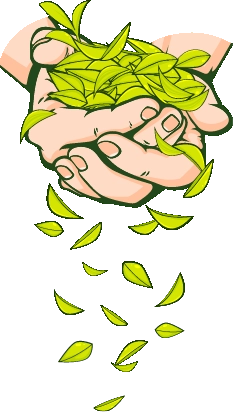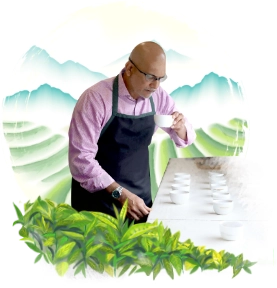From Meditating Monks to Mindful Millennials : The Metamorphosis of Tea
Tea’s origins in China can be traced back to around 2737 BCE, according to legend, when Emperor Shen Nong accidentally discovered tea leaves falling into a pot of boiling water. Initially used for its medicinal properties, tea was believed to have various health benefits and was consumed for its potential healing effects. The early teas were likely a simple infusion of tea leaves in hot water.
Tea drinking has a rich and intricate history that spans over 4,000 years, evolving through various cultures and regions. The evolution of tea – from a hot drink of meditating Buddhist monks in China to the last drink of the samurai warriors in Japan to a symbol of aristocracy in Britain to the pitcher-fulls of iced tea in America to the syrupy-sweet-spicy masala chai in India – is indeed fascinating.
Brewing Green Tea as a Medicinal Drink
This early form of tea was primarily used for medicinal purposes due to its perceived health benefits. Tea was one of the plants amongst the many medicinal plants cultivated by monks and herbalists. Tea leaves were plucked, dried, and then brewed in hot water to create a simple infusion. This early form of tea consumption was driven by the belief in tea’s healing properties and health benefits. It was often used as a remedy for various ailments and was considered a way to promote wellness. Needless to say, this was green tea.
Boiling Tea for Pleasure
During the Han Dynasty (206 BCE – 220 CE), tea consumption expanded beyond its medicinal use. Tea leaves were now boiled, creating a beverage that was enjoyed for its flavor and taste. The process of boiling tea involved simmering the leaves in water, often with the addition of various herbs, spices, or other flavorings. This marked the beginning of tea’s transition from a purely medicinal drink to a beverage of
Whisking Tea – The Beginning of Matcha
By the Tang Dynasty (618-907 CE), the method of whisking powdered tea leaves in hot water gained popularity. This method involved grinding tea leaves into a fine powder, which was then whisked together with hot water using a specialized bamboo whisk. The resulting frothy mixture was consumed, creating a textured and aromatic tea experience. This tea is called Matcha, which would go on to become the central element of the famous Japanese tea ceremony.
Steeping Loose-Leaf Tea
As tea culture continued to develop, the Song Dynasty (960-1279 CE) witnessed the emergence of steeping loose-leaf tea, which is a method still widely used today. During this period, tea leaves were steeped in hot water in various vessels, such as bowls or cups. This practice allowed the drinker to appreciate the flavor and aroma of the tea leaves themselves, without additional additives.
From Green to Black
For almost 4,000 years, the only form of tea that existed was Green tea. It was during the Ming Dynasty (1368-1644) that the first black tea was discovered.
It’s important to note that what is considered “black tea” in China is often referred to as “dark tea.” Dark tea includes both what Western countries refer to as black tea (fully oxidized) and post-fermented teas like Pu-erh. During the Ming and Qing Dynasties, dark tea production flourished in regions like Fujian, where the famous Wuyi Mountain teas were processed. These teas, known as “rock teas” or “yan cha,” were roasted and fully oxidized, resulting in dark, robust, and aromatic infusions.
Lapsang Souchong – The First Black Tea
While there is no definitive proof about which is the first black tea, it is widely believed that Lapsang Souchong is the first black tea. Lapsang Souchong is a Chinese black tea with a distinctive smoky aroma and flavor.
According to one account, during the Qing Dynasty (17th – 19th century), villagers in the Wuyi Mountains in Fujian Province accidentally left their tea leaves out in the open, allowing them to oxidize and develop a dark color. In order to salvage the tea, they decided to dry the leaves quickly over an open fire, which imparted the unique smoky flavor that is characteristic of Lapsang Souchong. This accidental process resulted in a fully oxidized, black tea that was different from the traditional green tea commonly consumed at the time.
Tea Travels West – and Milk Tea Makes an Appearance
Tea was introduced to the West in the early 17th century, primarily through European traders and explorers who established trade routes with Asia. Portuguese and Dutch merchants were among the first to bring tea to Europe. Initially, tea was a luxury enjoyed by the aristocracy and elite classes due to its scarcity and high cost.
It is thought that it was the Dutch who first started to add milk to their tea. There are two main reasons for this : firstly, as tea was very costly but milk was abundant, adding milk to tea ensured the costly tea could last longer; secondly, most of the tea that reached homes deteriorated in quality due to the long voyage, and hence, became bitter. Adding milk (and sugar) made it more palatable.
From Milk Tea to Masala Chai
Tea cultivation in India started in the early 19th century with the discovery of the native variety of tea plant in the present day state of Assam in north-east India, along the banks of the mighty Brahmaputra river. By the end of the 19th century, huge amounts of black tea from India were being exported by the British East India Company all over the world. However, there was a problem – only the whole leaf and larger brokens grade of tea was exported, while lower grades like fanning and dust had no takers. The British introduced tea to Indians and followed it up with massive promotions, even distributing tea free! But this new brew was strong and bitter for the Indians. It was the Indian traders – particularly from the western part, who solved this problem by adding sugar and spices like cardamom, black pepper, fresh and/or dried ginger, cinnamon, nutmeg – to make the tea sweet and aromatic. The famous Indian Masala Chai was born!
An American Ingenuity called Iced Teas
One popular story attributes the creation of iced tea to the 1904 World’s Fair in St. Louis, Missouri, USA. According to the tale, a tea merchant named Richard Blechynden had set up a booth to promote his hot tea. However, due to the sweltering heat, fairgoers showed little interest in hot beverages. In a creative response, Blechynden poured his tea over ice and served it cold. The chilled tea was an instant hit, and iced tea’s popularity began to grow.
Today, iced tea is the most popular form of tea consumed in the USA.
Tea Bags – the Unintentional Invention
In 1826, a British merchant named Thomas Sullivan unintentionally invented the prototype for the modern tea bag. Sullivan, looking to reduce his packaging costs, sent tea samples to customers in small silk bags. Instead of removing the tea from the bags, customers simply steeped the entire bag, discovering that the enclosed tea leaves brewed just as well as loose tea. But it took another century before the tea-bags that we are so familiar with today came to being. The silk was replaced by muslin, and then eventually by filter-paper. The traditional pocket-shaped square or rectangular shape was replaced by the round tea bag as well as the double-chambered tea bag. In the late 19th century, the tetrahedral tea bags, also popularly known as pyramid tea bags, were introduced.
In an Instant (Tea)
Till about a hundred years ago, all tea needed to be brewed from the leaves. Except Matcha tea, which was the only 100% soluble tea, all other teas need to be made from tea leaves. It was in the 1930s and 1940s that inventors were able to create a process to make soluble tea granules, which proved to be a boon for the soldiers during the second world war. In the latter half of the 20th century, instant tea was blended with various flavours to create innovative instant teas that could be consumed both hot and iced.
The Mindful Millennials
Tea is currently undergoing yet another transformation as it evolves into flavour, fruit and spice teas. With the millennials demanding a fun, healthy and mindful product, tea is being blended with herbs, spices, fruits and flowers to create a myriad range of exciting products that are both delicious and healthy.
From the simple and serene green tea that the meditating monks were allowed almost five thousand years ago, to the chic and stylish tea infusion the millennials love, tea has proved that it is capable of metamorphosis – and evolving into a new avatar that is loved by every generation.

Tea is a religion in the art of life.

